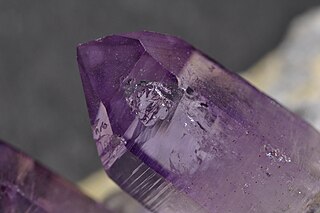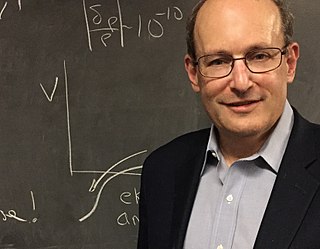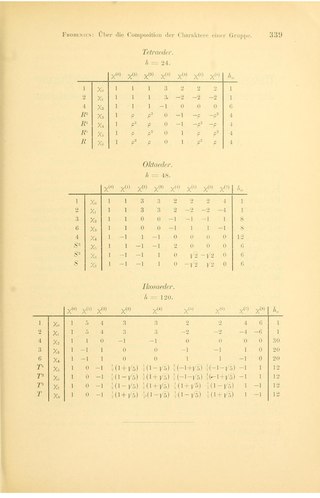
A crystal or crystalline solid is a solid material whose constituents are arranged in a highly ordered microscopic structure, forming a crystal lattice that extends in all directions. In addition, macroscopic single crystals are usually identifiable by their geometrical shape, consisting of flat faces with specific, characteristic orientations. The scientific study of crystals and crystal formation is known as crystallography. The process of crystal formation via mechanisms of crystal growth is called crystallization or solidification.

Crystallography is the experimental science of determining the arrangement of atoms in crystalline solids. Crystallography is a fundamental subject in the fields of materials science and solid-state physics. The word crystallography is derived from the Ancient Greek word κρύσταλλος, and γράφειν. In July 2012, the United Nations recognised the importance of the science of crystallography by proclaiming that 2014 would be the International Year of Crystallography.

A quasiperiodic crystal, or quasicrystal, is a structure that is ordered but not periodic. A quasicrystalline pattern can continuously fill all available space, but it lacks translational symmetry. While crystals, according to the classical crystallographic restriction theorem, can possess only two-, three-, four-, and six-fold rotational symmetries, the Bragg diffraction pattern of quasicrystals shows sharp peaks with other symmetry orders—for instance, five-fold.

An aperiodic tiling is a non-periodic tiling with the additional property that it does not contain arbitrarily large periodic regions or patches. A set of tile-types is aperiodic if copies of these tiles can form only non-periodic tilings.

Robert Ammann was an amateur mathematician who made several significant and groundbreaking contributions to the theory of quasicrystals and aperiodic tilings.

Paul Joseph Steinhardt is an American theoretical physicist whose principal research is in cosmology and condensed matter physics. He is currently the Albert Einstein Professor in Science at Princeton University, where he is on the faculty of both the Departments of Physics and of Astrophysical Sciences.

Dan Shechtman is the Philip Tobias Professor of Materials Science at the Technion – Israel Institute of Technology, an Associate of the US Department of Energy's Ames National Laboratory, and Professor of Materials Science at Iowa State University. On April 8, 1982, while on sabbatical at the U.S. National Bureau of Standards in Washington, D.C., Shechtman discovered the icosahedral phase, which opened the new field of quasiperiodic crystals.
In geometry, a tile substitution is a method for constructing highly ordered tilings. Most importantly, some tile substitutions generate aperiodic tilings, which are tilings whose prototiles do not admit any tiling with translational symmetry. The most famous of these are the Penrose tilings. Substitution tilings are special cases of finite subdivision rules, which do not require the tiles to be geometrically rigid.
In physics, a phason is a form of collective excitation found in aperiodic crystal structures. Phasons are a type of quasiparticle: an emergent phenomenon of many-particle systems. Similar to phonons, phasons are quasiparticles associated with atomic motion. However, whereas phonons are related to the translation of atoms, phasons are associated with atomic rearrangement. As a result of this rearrangement, or modulation, the waves that describe the position of atoms in the crystal change phase -- hence the term "phason".

Khatyrkite is a rare mineral which is mostly composed of copper and aluminium, but may contain up to about 15% of zinc or iron. Its chemical structure is described by an approximate formula (Cu,Zn)Al2 or (Cu,Fe)Al2. It was discovered in 1985 in a placer in association with another rare mineral cupalite. These two minerals have only been found at 62°39′11″N174°30′02″E in the area of the Iomrautvaam, a tributary of the Khatyrka river, in the Koryak Mountains, in Anadyrsky District, Chukotka, Russia. Analysis of one of the samples containing khatyrkite showed that the small rock was from a meteorite. A geological expedition has identified the exact place of the original discovery and found more specimens of the Khatyrka meteorite. The mineral's name derives from the Khatyrka zone where it was discovered. Its type specimen is preserved in the Mining Museum in Saint Petersburg, and parts of it can be found in other museums, such as Museo di Storia Naturale di Firenze.

A Penrose tiling is an example of an aperiodic tiling. Here, a tiling is a covering of the plane by non-overlapping polygons or other shapes, and a tiling is aperiodic if it does not contain arbitrarily large periodic regions or patches. However, despite their lack of translational symmetry, Penrose tilings may have both reflection symmetry and fivefold rotational symmetry. Penrose tilings are named after mathematician and physicist Roger Penrose, who investigated them in the 1970s.
A Euclidean graph is periodic if there exists a basis of that Euclidean space whose corresponding translations induce symmetries of that graph. Equivalently, a periodic Euclidean graph is a periodic realization of an abelian covering graph over a finite graph. A Euclidean graph is uniformly discrete if there is a minimal distance between any two vertices. Periodic graphs are closely related to tessellations of space and the geometry of their symmetry groups, hence to geometric group theory, as well as to discrete geometry and the theory of polytopes, and similar areas.
Peter Kramer is a German physicist.
In differential geometry, the Schwarz minimal surfaces are periodic minimal surfaces originally described by Hermann Schwarz.
Marjorie Lee Senechal is an American mathematician and historian of science, the Louise Wolff Kahn Professor Emerita in Mathematics and History of Science and Technology at Smith College and editor-in-chief of The Mathematical Intelligencer. In mathematics, she is known for her work on tessellations and quasicrystals; she has also studied ancient Parthian electric batteries and published several books about silk.

An icosahedral twin is a nanostructure appearing in atomic clusters and also nanoparticles with some thousands of atoms. These clusters are twenty-faced, with twenty interlinked tetrahedral crystals joined along triangular faces having three-fold symmetry. A related, more common structure has five units similarly arranged with twinning, which were known as "fivelings" in the 19th century, more recently as "decahedral multiply twinned particles", "pentagonal particles" or "star particles". A variety of different methods lead to the icosahedral form at size scales where surface energies are more important than those from the bulk.
Quasicrystals and Geometry is a book on quasicrystals and aperiodic tiling by Marjorie Senechal, published in 1995 by Cambridge University Press (ISBN 0-521-37259-3).
Dov I. Levine is an American-Israeli physicist, known for his research on quasicrystals, soft condensed matter physics, and statistical mechanics out of equilibrium.

In applied mathematics, finite subgroups of SU(2) are groups composed of rotations and related transformations, employed particularly in the field of physical chemistry. The symmetry group of a physical body generally contains a subgroup of the 3D rotation group. It may occur that the group {±1} with two elements acts also on the body; this is typically the case in magnetism for the exchange of north and south poles, or in quantum mechanics for the change of spin sign. In this case, the symmetry group of a body may be a central extension of the group of spatial symmetries by the group with two elements. Hans Bethe introduced the term "double group" (Doppelgruppe) for such a group, in which two different elements induce the spatial identity, and a rotation of 2π may correspond to an element of the double group that is not the identity.











